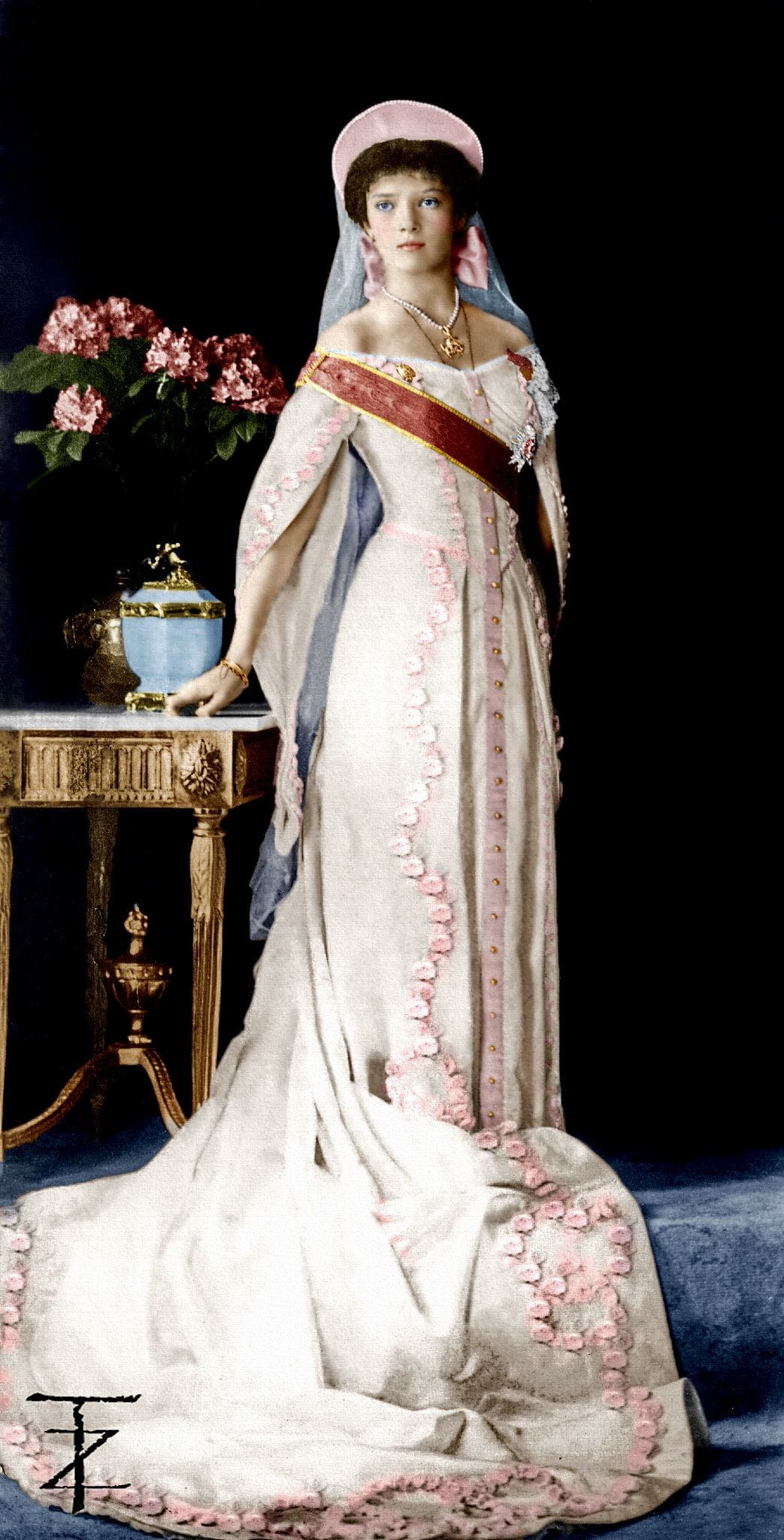Step into the captivating world of Grand Duchess Tatiana Nikolaevna of Russia, a woman whose life embodied elegance, responsibility, and a depth of character often overshadowed by the grandeur and turmoil of early 20th century Russia. Uncover the true essence of Tatiana, her kind heart, unwavering faith, and the lasting mark she left on the world. Beyond her captivating beauty and royal lineage, discover the story of a remarkable young woman whose legacy continues to resonate today.
A Glimpse into the World of Grand Duchess Tatiana
Born into the dazzling spectacle of the Romanov dynasty, Grand Duchess Tatiana Nikolaevna of Russia was a captivating blend of grace and strength, privilege and compassion. As the second daughter of Tsar Nicholas II and Tsarina Alexandra, she inhabited a world of opulence most could only imagine, residing in the lavish palaces of St. Petersburg. Yet, beneath the surface of glittering balls and extravagant gifts, Tatiana was absorbing the weight of her Romanov heritage, embracing the values of duty and compassion.
Tatiana and her sisters, Olga, Maria, and Anastasia, shared an unbreakable bond. Affectionately known as “OTMA,” they were more than royal siblings; they were the best of friends. The sisters shared everything, from lighthearted jokes to whispered secrets. This bond deepened as the shadow of World War I stretched across their once-charmed lives.
Driven by a profound sense of duty to their country and its people, Tatiana and her sisters refused to remain sheltered. They trained as Red Cross nurses, exchanging their opulent gowns for the simple uniforms of caregivers. Imagine these young women, accustomed to every comfort imaginable, tending to wounded soldiers in a makeshift hospital at Tsarskoye Selo. Their presence, compassion, and willingness to serve offered a beacon of hope amidst the unimaginable chaos of war.
However, the world Tatiana knew was on the brink of collapse. The Russian Revolution of 1917 tore through Russia, shattering the Romanovs’ tranquil world and irrevocably altering their lives. The family, once adored, was stripped of their titles and privileges, placed under house arrest, and eventually imprisoned in the remote town of Yekaterinburg.
Even as their world crumbled, Tatiana’s spirit never wavered. She remained a pillar of strength for her siblings, offering comfort and support in their darkest hours. Tragically, their confinement was short-lived. On the night of July 17, 1918, the Romanov family met a brutal and untimely end in the basement of the Ipatiev House, their lives extinguished in a horrifying act of violence that sent shockwaves around the world.
The story of Grand Duchess Tatiana Nikolaevna is a poignant tapestry woven from privilege and tragedy. Her letters and diaries, offering a glimpse into her thoughts and feelings, provide invaluable insights into the final days of the Russian Empire and the indomitable spirit of a young woman who faced her fate with enduring courage and grace.
Did Any Romanov Daughter Survive?
The tragic fate of the Romanovs during the Russian Revolution continues to fascinate and haunt us. One of the most enduring questions surrounding this historical tragedy is whether any of the Tsar’s daughters managed to escape the massacre. Rumors have persisted for decades, particularly surrounding Grand Duchess Anastasia, the youngest Romanov daughter. However, historical and scientific evidence suggests that, sadly, none of the Romanov daughters survived.
The discovery of Romanov remains in 1991, followed by DNA testing, and the subsequent discovery of additional remains in 2007, paint a grim picture. The scientific analysis overwhelmingly points to the conclusion that all four daughters—Olga, Tatiana, Maria, and Anastasia—were tragically killed alongside their family.
While numerous individuals have come forward claiming to be Anastasia, scientific analysis has definitively proven that the entire Romanov family, including all four daughters, perished together. The discovery of the final Romanov remains in 2007 effectively closed a painful chapter in Russian history, confirming the tragic fate of Tsar Nicholas II, his wife, and their five children.
Tatiana, known for her kindness and unwavering strength, embodies the tragedy that befell the Romanov family. Born in 1897, she led a life punctuated by both privilege and hardship. During World War I, she served as a Red Cross nurse, demonstrating her deep compassion and commitment to others. The events of 1917 and the Russian Revolution brought about a swift and devastating fall from grace for the Romanov dynasty. Imprisoned along with her family, Tatiana faced the uncertainty and fear of their captivity with remarkable resilience. The brutal execution of the Romanovs in 1918 serves as a stark reminder of the capricious nature of fate and the human cost of political upheaval.
Romanov Daughter Survival: SEO Analysis & Content Strategy
Recommended Titles (Based on Competitor Analysis):
- Debunking the Romanov Daughter Survival Myth: The Truth Revealed (Leans into dispelling myths, uses strong language)
- Did Any Romanov Child Survive? Unraveling the Fate of the Tsar’s Children (Broadens scope to all children, intriguing for wider audience)
- Anastasia & Her Sisters: The Romanov Daughters and Their Tragic End (Focuses on the human element, emotional appeal for readers)
Powerful Key Lines:
- DNA evidence confirms that none of the Romanov daughters survived the 1918 execution, finally putting an end to decades of speculation and conspiracy theories. (Direct, conclusive, keyword-focused)
- While numerous impostors emerged claiming to be Anastasia, scientific analysis has definitively proven that the entire Romanov family, including all four daughters, perished together. (Highlights impostors, reinforces scientific debunking)
- The discovery of the final Romanov remains in 2007 closed a painful chapter in Russian history, confirming the tragic fate of Tsar Nicholas II, his wife, and their five children. (Contextualizes the event, emphasizes the tragedy of the entire family)
- Despite persistent rumors and romanticized stories, the truth about the Romanov daughters is a somber one: their lives were cut short, leaving behind a legacy of loss and unfulfilled potential. (Emphasizes the emotional impact, contrasts with romanticized narratives)
What Happened to Tatiana Romanov?
Tatiana, the second daughter of Tsar Nicholas II and Tsarina Alexandra, met a tragic end alongside her family during the Russian Revolution. Imprisoned with her family by Bolshevik revolutionaries, Tatiana’s life was tragically cut short on that fateful night in July 1918, in the Ipatiev House in Yekaterinburg. Despite the unimaginable hardships she faced during their imprisonment, Tatiana remained a source of strength and comfort for her siblings.
The aftermath of the execution was shrouded in mystery and fueled by speculation. Whispers of survival, particularly regarding Tatiana’s younger sister Anastasia, echoed through the years. However, scientific advancements in DNA analysis have provided irrefutable evidence, confirming that the remains discovered were those of all five Romanov children, including Tatiana. This discovery put to rest the long-held rumors of survival, confirming their tragic fate.
What Happened to Tatiana Romanov? Research Analysis:
Recommended Titles:
Competitor Title Analysis: The titles mostly focus on Tatiana’s identity (“Who was…”), her death (“Murder of…”, “tragic fate”), or Anastasia’s survival.
Suggested Titles:
- Tatiana Romanov: Beyond Anastasia’s Shadow – The Life & Death of a Grand Duchess (Combines Tatiana’s identity, fate, and hints at overshadowing by Anastasia)
- The Untold Story of Tatiana Romanov: From Imperial Privilege to Bolshevik Execution (Emphasis on a narrative arc, potentially unexplored details)
- Tatiana Romanov and the Romanov Sisters: A Family’s Tragic End in Revolutionary Russia (Broadens scope to sisters, potentially attracting wider audience)
How Old Was Grand Duchess Anastasia Nikolaevna of Russia When She Died?
Imagine the weight of history falling upon such young shoulders. Grand Duchess Anastasia, the youngest Romanov daughter, was merely 17 years and one month old when she was tragically executed alongside her family. On July 17, 1918, the course of history shifted as the Bolsheviks carried out their brutal act, silencing the Romanov dynasty. Despite her young age, Anastasia’s story continues to captivate people worldwide, symbolizing innocence lost amidst the chaos and brutality of the Russian Revolution.
Born on June 18, 1901, in Peterhof, Russia, Anastasia’s life began in a world of unimaginable privilege and power. However, the dark turn of history would soon cast a long shadow over the Romanov family. For years following their execution, whispers and rumors of Anastasia’s survival circulated, fueled by a desire for a less tragic ending. However, scientific advancements allowed for DNA testing on the discovered Romanov remains, irrefutably confirming that Anastasia perished alongside her family on that fateful day in July 1918.
Unlocking the Mystery: How Old Was Grand Duchess Anastasia at Her Death?
Recommended Titles:
- Anastasia Romanov: Unraveling the Age and Legacy of the Lost Grand Duchess (This title combines historical intrigue with a focus on Anastasia’s age at death).
- The Life and Death of Anastasia: Debunking Myths and Revealing the Truth (Appeals to readers interested in historical mysteries and promises concrete answers).
- 17 Years and a Mystery: The Short Life and Enduring Legend of Anastasia Romanov (Highlights Anastasia’s young age and the enduring fascination surrounding her).
People’s statements should remain as in the original source for accuracy.
Do you wish to discover more about the Italian poisoner who sold cosmetics containing arsenic, Giulia Tofana? Or how about Grace Marks, the Irish-Canadian woman who was accused of murder but later acquitted? If you want to know more about **the woman who saved hundreds of Jewish children from the Nazis during the Holocaust, Grete Winton ** then read this article.
- Unlocking Francis Alexander Shields’ Finance Empire: A Comprehensive Biography - July 12, 2025
- Unveiling Francis Alexander Shields: A Business Legacy - July 12, 2025
- Francis Alexander Shields’ Business Career: A Comprehensive Overview - July 12, 2025















